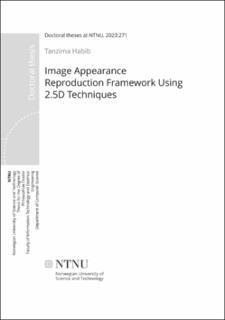| dc.contributor.advisor | Green, Phil | |
| dc.contributor.author | Habib, Tanzima | |
| dc.date.accessioned | 2023-11-20T13:10:31Z | |
| dc.date.available | 2023-11-20T13:10:31Z | |
| dc.date.issued | 2023 | |
| dc.identifier.isbn | 978-82-326-7241-7 | |
| dc.identifier.issn | 2703-8084 | |
| dc.identifier.uri | https://hdl.handle.net/11250/3103611 | |
| dc.description.abstract | Light plays a crucial role in the perception of the world around us, as it interacts with objects and stimulates our eyes to create visual images. Appearance is the result of human visual perception of the interaction of light with the surface of objects and is defined as the aspect of visual perception by which objects are recognised. One of the most easily quantifiable aspects of appearance is colour, which is represented by the CIE tristimulus values. This is the sum of the product of the spectral power distribution of light, the colour matching functions, and the reflectance or transmittance of an object. However, this limited perception of colour due to the response of only three types of cone cells in the retina can lead to metamerism, that is, when two objects with different reflectances can match in colour under one illuminant but not under another. Spectral reproduction is a solution to this issue, but spectral data is not always available, making spectral estimation an important area of research.
Understanding and measuring appearance attributes such as colour, gloss, translucency, and texture are important to control printer attributes that enable accurate object creation or accurate soft proofing. A generic 2.5D printing pipeline includes having a 3D surface model and its corresponding colour map and height map to print. The 3D surface structure is first printed primarily with white deposit, then colours are printed on top as the final layer with half-toning using ink deposition and drying by UV curing. The elevation of the surface is achieved by assigning the height map corresponding to the original 3D model. The number of ink layers required to print the elevated 3D structure layer by layer from the bottom to the top is quantified by slicing. The final colour printed on top uses the colour map and an ICC profile that converts the colour map values to printer colours through the ink separation employed, as is traditionally done for 2D printing. Colour management is currently carried out using a flat colour target that is printed, measured, and mapped to the printer colours, and this mapping is encoded inside the ICC profile. Such an ICC profile is also used for soft proofing in 2D printing.
The aim of this work is to establish a strong framework for spectral estimation as a means of reducing metamerism and its integration into existing colour management workflows and to design an appearance reproduction framework for 2.5D printing using the current colour management architecture called iccMAX.’ | en_US |
| dc.language.iso | eng | en_US |
| dc.publisher | NTNU | en_US |
| dc.relation.ispartofseries | Doctoral theses at NTNU;2023:271 | |
| dc.relation.haspart | Paper 1: Habib, Syeda Tanzima; Green, Philip John; Nussbaum, Peter. Spectral reproduction: drivers, use cases and workflow.. Electronic Imaging in Proceedings. IS&T Int’l. Symp. on Electronic Imaging: Color Imaging XXV: Displaying, Processing, Hardcopy, and Applications, 2020, pp 121-1 - 121-6, https://doi.org/10.2352/ISSN.2470-1173.2020.15.COLOR-121 | en_US |
| dc.relation.haspart | Paper 2:
Habib, Syeda Tanzima; Green, Philip John; Nussbaum, Peter.
Spectral estimation: Evaluation and Application | en_US |
| dc.relation.haspart | Paper 3:
Habib, Syeda Tanzima; Green, Philip John; Nussbaum, Peter.
Spectral estimation: As a Sensor Adjustment Transform | en_US |
| dc.relation.haspart | Paper 4: Habib, Syeda Tanzima; Green, Philip John; Nussbaum, Peter. Estimation of BRDF Measurements for Printed Colour Samples. Color and Imaging Conference (CIC) 2021 s. 123-128 https://doi.org/10.2352/issn.2169-2629.2021.29.123 This work is licensed under the Creative Commons Attribution 4.0 International License. | en_US |
| dc.relation.haspart | Paper 5: Habib, Syeda Tanzima; Green, Philip John; Nussbaum, Peter. BRDF rendering by interpolation of optimised model parameters. Color and Imaging Conference (CIC) 2020 https://doi.org/10.2352/issn.2169-2629.2020.28.25 This work is licensed under the Creative Commons Attribution 4.0 International License | en_US |
| dc.relation.haspart | Paper 6: Habib, Syeda Tanzima; Green, Philip John; Sole, Aditya Suneel. Implementing Directional Reflectance in a Colour Managed Workflow. I: London Imaging Meeting 2020: Future Colour Imaging. https://doi.org/10.2352/issn.2694-118X.2020.LIM-33 This work is licensed under the Creative Commons Attribution 4.0 International License (CC BY 4.0) | en_US |
| dc.relation.haspart | Paper 7:
Habib, Syeda Tanzima.
Colour Management of Material Appearance | en_US |
| dc.relation.haspart | Paper 8:
Habib, Syeda Tanzima; Green, Philip John; Nussbaum, Peter.
2.5D Printing: An Appearance Reproduction Framework for Printed 3D Surfaces | en_US |
| dc.relation.haspart | Paper 9:
Habib, Syeda Tanzima; Green, Philip John; Nussbaum, Peter.
‘A weighted goodness-of-fit metric for comparison of spectra,’ in Sensing Colour, Proceedings of the International Colour Association (AIC) Conference 2022, International Colour Association, 2022, pp. 397–404 https://aic-color.org/resources/Documents/AIC2022-Conference_Proceedings.pdf | en_US |
| dc.title | Image Appearance Reproduction Framework Using 2.5D Techniques | en_US |
| dc.type | Doctoral thesis | en_US |
| dc.subject.nsi | VDP::Technology: 500::Information and communication technology: 550 | en_US |

